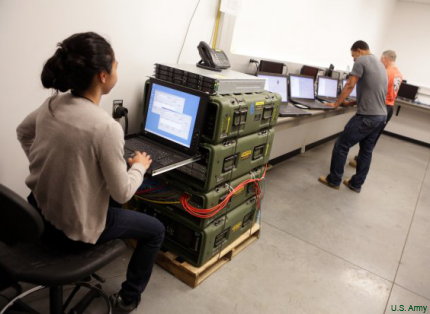Old school cost-cutting: when reused components work just fine
The Army’s Tactical Mission Command finds that not every part of the Command Post of the Future has to be new.

Workers at Tactical Mission command load CPOF software onto new Dell laptops.
With budgets shrinking, military organizations have explored a number of ways to cut costs, from consolidating data centers to tapping renewable energy sources. The Army’s Tactical Mission Command has found another way, taking an old-school approach to refreshing the Command Post of the Future (CPOF) systems used throughout the service.
The command took to researching the idea of reusing some of the components of CPOF systems, which general are on a five-year refresh cycle, and only replacing the parts that were necessary, the Army said in a release. http://www.army.mil/article/133856/Discovering_cost_avoidance_through_reuse____what_s_old_is_new_again_for_CPOF_users/ Researchers found that, aside from a system’s most expensive component—a laptop—many of the components were in good enough shape to stay in service.
"We ultimately identified a plan to retain all of CPOF's capabilities with about a 25 percent decrease per client in cost," said Angel Acevedo, former assistant program manager for the command, assigned to Project Manager Mission Command.
CPOF systems, which delver command and control functions, situational awareness and battlefield information to the screen, includes a laptop, monitor, extra keyboard, mouse, headset, cables and carrying case. When refreshing systems, the laptop is replaced, to take advantage of processing power improvements that can handled upgraded software, but the other elements often can be tested and restored to the system, the Army said.
In the refresh process—called the Service Life Extension Plan, or SLEP—the command purchases new Dell M6700 laptops and sends each one with a CPOF client package to Tobyhanna Army Depot, Pa., where the components are tested. Some components might be replaced or upgraded if necessary, such as a keyboard or the insulation in the carrying case. Workers then attach the components to the laptop and test the system as a unit, and eventually send it back to the Tactical Mission Command at Aberdeen Proving Ground, Md., where technicians install the latest versions of CPOF software. At that point, it’s ready for the field.
The command buys the laptops through the Army’s Product Director Common Hardware Systems, which provides a five-year warranty, so the biggest piece of the command post is guaranteed until the next refresh.
"I just kept going back to my own experiences," Acevedo said. "I bought a refurbished Mac for $800 that normally sold for $2,000 and it not only works fine, it has the same warranty."
SLEP has another advantage: less hazardous waste to get rid of. Reused parts don’t have to be thrown out and even some of the components that are replaced, including laptops, are kept on hand at Tobyhanna as spare parts and possible replacements, which could come in handy if further budget cuts deny new equipment to some units.
The command expects to have refreshed/refurbished 1,500 CPOF clients in the second quarter of fiscal 2014, with cost avoidance for the year estimated to be $1.7 million. The savings are expected to grow to $3.3 million in fiscal 2015 and 44.4 million in fiscal 2015.




